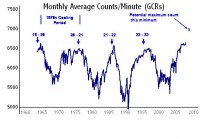By Anthony Watts, Watts Up with That
After going days without counting the August 21/22 “sunspec” SIDC Brussels now say it was NOT a spotless month!
They officially counted that sunspeck, after all. It only took them a week to figure out if they were going to count it or not, since no number was assigned originally.
But there appears to be an error in the data from the one station that reported a spot, Catania, Italy. No other stations monitoring that day reported a spot. Catania reports a spot in the southern hemisphere that day, but there was not one seen by anyone else.
For example, at the 150 foot solar solar tower at the Mount Wilson Observatory, the drawings from those dates show no spots at all: See those drawings here and here.
Inquires have been sent, stay tuned. Here is an exchange in comments from Leif Svalgaard.
REPLY: So What gives Leif? You yourself said these sunspecks weren’t given a number. I trusted your assessment. Hence this article. Given the Brussels folks decided to change their minds later, what is the rationale ? - Anthony
The active region numbering is done by SIDC, not by Brussels. The Brussels folks occasionally disagree. In this case, they did. Rudolf Wolf would not have counted this spot. Nor would I. What puzzles me is this:
21 7 4 3
22 8 4 4
The 3rd column are ‘spots’ in the Northern hemisphere, and the 4th column are ‘spots’ in the Southern hemisphere [both weighted with the ‘k’-factor: SSN = k(10g+s)]. But there weren’t any in the south. The Catania spot was at 15 degrees north latitude, IIRC. Maybe the last word is not in on this.
Hmm. Apparently there’s some backstory to this. - Anthony. See more here.
Icecap Update: The official SIDC number may come in at 0.2 which has occurred twice since 1913 in 1933 and 1954. I received this interesting e-mail from David Archibald today about the cosmic rays which are at the highest levels since 1963 do to this low solar activity and likely to go higher. More cosmic rays provide more seed nuclei for clouds in Earth’s atmosphere. More clouds mean a greater albedo and less terrestrial solar radiation, which translates to lower temperatures.
“One thing to keep up with is the neutron monitor count. I follow Oulu. The month of August has had the highest count since 1963. We are still nine months off solar minimum and the count might continue to rise for a year after that. I am predicting a maximum count for this solar minimum of 6,900 in mid-2010.

See larger image here
The delay from solar minimum is because it takes a year, not a village, for the solar wind to get to the heliopause, and for the GCRs to come back in. The solar minima are marked. Note the high solar count associated with the 1970s cooling period. Real world application of Svensmark’s theory is happening now.”




